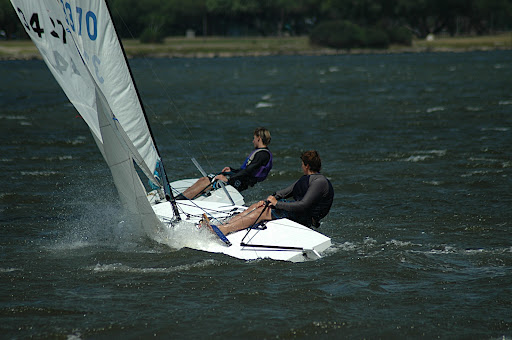If you’re keen to race your sailing dinghy, but find it difficult to get out of that part of the fleet that makes the top half possible, there may be a few reasons.
For novice skippers it is mostly sail trimming that keeps them bringing up the rear. Concentrate on fore and aft and lateral trim, then pay some attention to your sail trim.
This discussion is not about the theory that makes a dinghy move through the water as a consequence of air movement across the sails; rather, it is a practical guide to effective sail trim on a small sailing dinghy. Please bear in mind that this is a general discussion, and will therefore not be equally suitable for all sailing dinghies.
Dinghy sail trimming starts on land, when you are rigging your dinghy.
Hoist your mainsail and jib.
When tensioning the sails, remember that the harder the wind is blowing, the harder you can apply tension to the sails. In light winds, apply very little pressure, to make your sails as full as possible. Light tension will also allow the sails to react to puffs quicker and easier.
Many, but not all mainsails have a luff lock position, some have more than one, to allow for different wind conditions, but most have no locking position. If your dinghy has a luff lock, and it is required to use it, do so. If not, read on.
The luff on a dinghy is elastic, and depending on how much tension is applied, will extend by as much as six inches, sometimes more. For light winds apply tension to the halyard, sufficient to increase the luff length by approximately two inches. A light fold should be seen in the sail, running parallel to the mast. Now go to the clew of the main, at the end of the boom. Apply pressure to remove the vertical luff fold. When the vertical fold has disappeared, watch the sail along the boom. Apply tension until you see a fold starting in the sail just above the boom. Now slowly release the clew to a point midway between the two extremes.
As the wind force accelerates, tighten your luff, then the foot of the sail, always maintaining the midway point. Apply pressure to remove the vertical fold. Stop, and mark the position. Now apply more pressure until a horizontal fold starts forming. Stop, and make a mark. The position you want is between the two marks. Experience with your dinghy will help you determine optimum settings.
Out on the water a common mistake made by novices is over-sheeting. This is pulling the sails in too tight. Nothing will slow a sailing dinghy down more than over-sheeting.
With your dinghy rigged, stand behind the dinghy and sheet in until the outside tip of the boom is above the outside corner of the transom. Use a permanent marker to mark the sheet at a point that you will be able to monitor easily. It is suggested that you use the boom block as a reference, as a deck block will divert your attention from what is happening around you. This will be your light weather setting. Now sheet in a bit more, until the tip of the boom is half way between the transom and the centerline. Mark this point with a permanent marker, and use it as a reference for maximum sheeting in strong winds.
Adjust your kicking strap, or boom vang. In light wind conditions the kicking strap must have very little tension, just sufficient to keep the boom from lifting up. In heavier conditions, you can apply tension that will drop the level of the boom below its actual rest position.
Jib luff tension is achieved by applying halyard tension until just before a vertical luff fold starts appearing.
Out on the water, launch your dinghy and get clear of land. Make sure your weight is correctly positioned, and steer a course to windward. Sheet in your mainsail, ensuring that it is between the marks you made earlier. Now adjust your course, so that the leech of the mainsail is just fluttering. Sheet the jib in to stop it flapping. Have a look at the leech of your mainsail. If it is opening excessively along the top third, you need to tighten your kicking strap. With time and practice you will be able to feel the difference this makes.
Now sheet the jib in some more, until it starts back-winding the main. You will see this happen when the beautiful aerofoil shape of the main starts making a bubble just behind the mast. Let the jib out until the bubble goes away.
These are the basics, and will make a difference to your position. By fine-tuning these settings you will notice if your ability to catch up is improving or not. Fine-tuning and practice will take you closer to the front of the fleet.





